49 Search Results for generalization
June 2, 2014
by Carole Zangari -
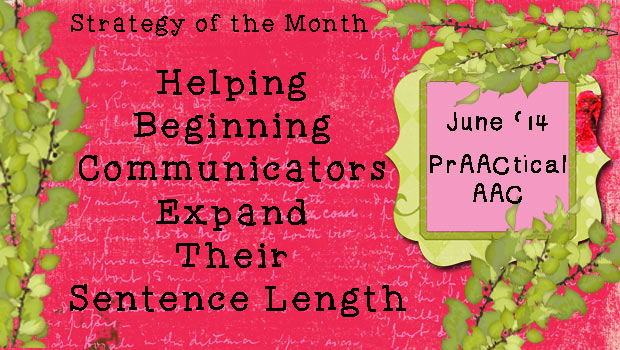
Nothing makes an AAC SLP happier than seeing beginning communicators start to use symbols to express themselves. Sure, it is great when a learner grabs your arm to lead you to the snack cupboard or hands you a juice box to get help opening it. Those are important communicative acts that we celebrate. But moving beyond pre-symbolic forms of communication to using signs and pictures, allows us to expand their vocabularies outside of the ‘here and now’ and enables them to communicate effectively with less familiar partners. When we’ve crossed the bridge into symbolic communication, we’re building a foundation for language development. If things go well, the learner will steadily acquire new symbols and words, eventually allowing us to work on word combinations. Are you working with AAC learners who at the early sentence level? If so, you may be considering how to build the length and complexity of their... [Read More...]
May 12, 2014
by Robin Parker -
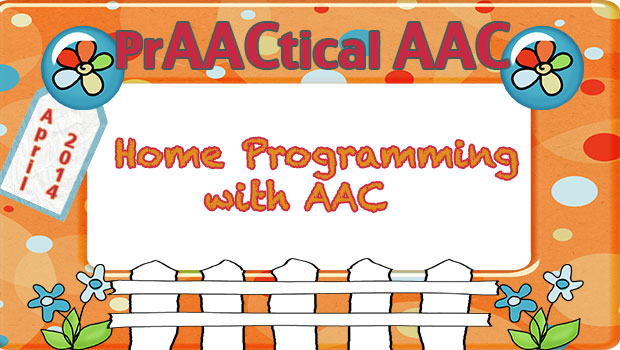
As SLP’s we love to have families learn and carryover the work we do in speech-language treatment sessions. This helps ensure carryover of progress and generalization of therapy success. However, as Carole clearly illustrated last Monday, there are a lot of family dynamics, cultural issues, and family challenges that make adding extra work possibly burdensome. We really (really) do not want to burden families, but its beneficial to have AAC communication happen all day long. We once had a client who had a very huge house with lots of bedrooms, but mom chose to keep her children together in one bedroom. This was just in case the AAC user woke in the middle of the night. Then she would have someone close by as a communication partner. This was a family who took home programming to the max and expanded and modified it to fit their family. A main issue... [Read More...]
September 10, 2013
by Carole Zangari -

There is no substitute for systematic instruction in reading and writing for building specific skills. AAC learners need high-quality instruction and lots of it. Beyond that, though, there are many ways to infuse literacy practice into the regular routine in therapy and at home. Writing for authentic purposes refers to experiences that reflect the writing activities of people in their regular lives. Authentic writing builds fluency, promotes skill generalization, and helps to build one’s self-concept as a writer. Plus, it’s fun, motivating, and pretty easy to do. Here are some things we try to do to include authentic writing experiences into our AAC therapies. 1. Sign in and out of the therapy session or classroom: Every AAC learner can do this. If the traditional sign-in form then doesn’t cut it, then make up a special sheet that has the client’s name in traceable letters, a name stamp, or placing a... [Read More...]
September 3, 2013
by Carole Zangari -

It’s a(nother) new semester for us and that means we get the chance to work with a whole new crop of graduate student SLPs who are learning to provide AAC services for the very first time. It just doesn’t get any better than that! One of the challenges for all beginning clinicians is deciding what intervention strategies to use to facilitate their clients’ learning in various areas. Recently, I had a wonderful conversation about the power of contrastive examples. I was taught this strategy by Dr. Ed Kame’enui and still use his ‘glerm’ activity today to illustrate the concept. The ‘glerm’ activity was quick way to demonstrate how to use carefully chosen examples to teach a new concept. Here’s the activity. You have to use your imagination and pretend this is a demonstration rather than a paper-and-pencil activity, but you’ll get the idea. And glerm is….? If I did a good... [Read More...]
July 27, 2013
by Carole Zangari -
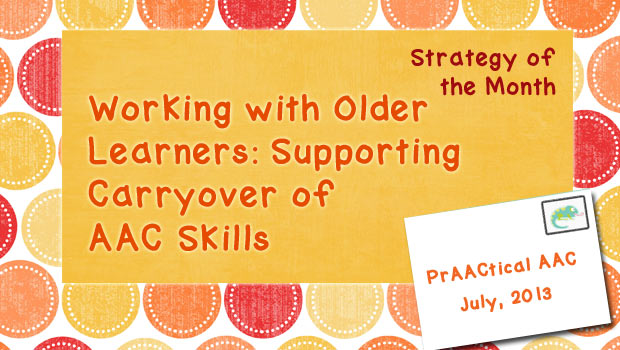
One of the biggest challenges that SLPs face is how to help the communicator use new skills outside the therapy room. Whether the client is someone who stutters, has voice problems, or any other speech-language difficulty, the question is the same: How can we get the client to use skills that were learned and practiced in a therapeutic situation to use those same skills at home, in school, and in the community? It’s an issue with all learners, but for adolescents and adults, we seem to be playing ‘catch up’ all the time. Plus, they are encountering greater numbers of less familiar communication partners and have to fend for themselves more often, making skill generalization even more of a critical topic. Much has been written about problems of generalization by using loose training, and varying the instructional setting, partners, instructions, prompts, and materials. In our way of thinking, it starts... [Read More...]
April 13, 2013
by Robin Parker -

The focus this month is on core word vocabulary and effective teaching strategies. Most core vocabulary is represented through abstract symbols that range from translucent (i.e., makes sense after it is explained) to opaque (i.e., doesn’t have any resemblance to the word or concept) which makes the need for effective teaching all the more important. It also makes it more fun because meaningful language experiences, emotional language experiences, and repetition with variety experiences are going to be the platform for teaching. Within the platform of authentic language experiences, layers of teaching strategies can be applied. The more strategies we apply to learning, the more we assure ALL learners will benefit from our teaching. Core word vocabulary teaching begins with a few premises that underlie the process. These are not new ideas but ones that should be reaffirmed as you begin teaching. It is important, as always, to presume competence. All learners... [Read More...]
October 30, 2012
by Carole Zangari -
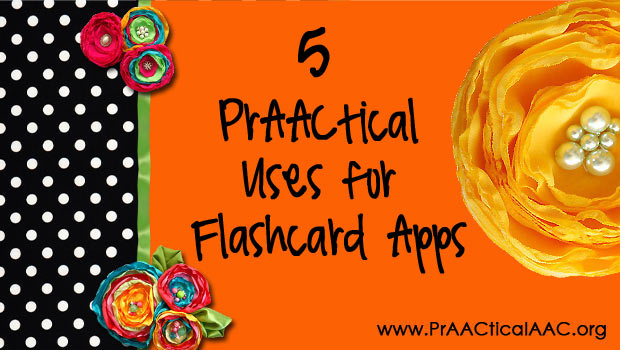
We love AAC intervention that begins and ends with a context that is meaningful to the learner. Not only is contextually relevant therapy more engaging and fun for the learner (thus, easier on the clinician!) but it promotes generalization to real-world contexts. So we’ve never been terribly fond of therapy that uses flash cards, or, more recently, the digital versions on iOS or Android devices. It’s a shame, really. There are a lot of those kinds of apps, and many of them have great graphics. That got us to starting thinking: What could we use them for that improves real communication and AAC learning? PrAACtical Uses for Flashcard Apps Make a Mini Schedule: Lots of people with AAC needs use paper-based picture schedules that depict the activities they do throughout the day. A flashcard app could be used in conjunction with those to show the steps or parts of an... [Read More...]
April 7, 2012
by Carole Zangari -
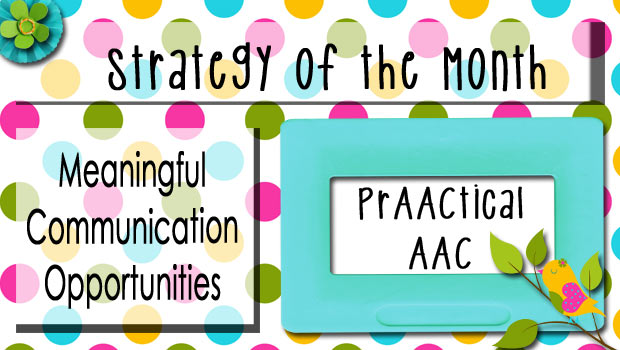
April is springtime where we live and spring is a time of beginnings. It’s fitting, then, that our AAC strategy of the month speaks to the very beginning of AAC intervention. Learning how to create focused opportunities to teach or practice an AAC skill is a pivotal skill for SLPs. The concept is a simple one: create an environment in which the learner WANTS or NEEDS to display the target skill. – Communication opportunities are related to the concept of communicative temptations. As SLP blogger Becca Jarzynski of Child Talk puts it “Communication temptations are pretty much just what they sound like: we set up the environment to tempt children to communicate with us.” Stop by and read her excellent post here . While Becca focuses on their use with young children, the approach can be used with people of any age. – Tempting people to communicate is all about... [Read More...]
March 3, 2012
by Carole Zangari -

Here’s a riddle for you. Read the clues and guess what tool or strategy we’re talking about. Clue #1: It’s used in almost every classroom and therapy room serving students with ASD. Clue #2: The one for Johnny looks almost the same as the one for Jenny. Clue #3: It looks as nice in June as it did in September. If you guessed visual schedules, you’ve just named our March Strategy of the Month. Visual Schedules? But everybody already uses those. Why post about those? — Here’s why. – They’re ubiquitous. And yet when we talk with educators and SLPs about how the children are doing with their schedules, we get a look and a shrug. “Okay, I guess.” To be sure, okay is better than not okay. But visual schedules have so much potential to make lives better for clinicians, educators, and people with AAC needs that okay isn’t... [Read More...]








